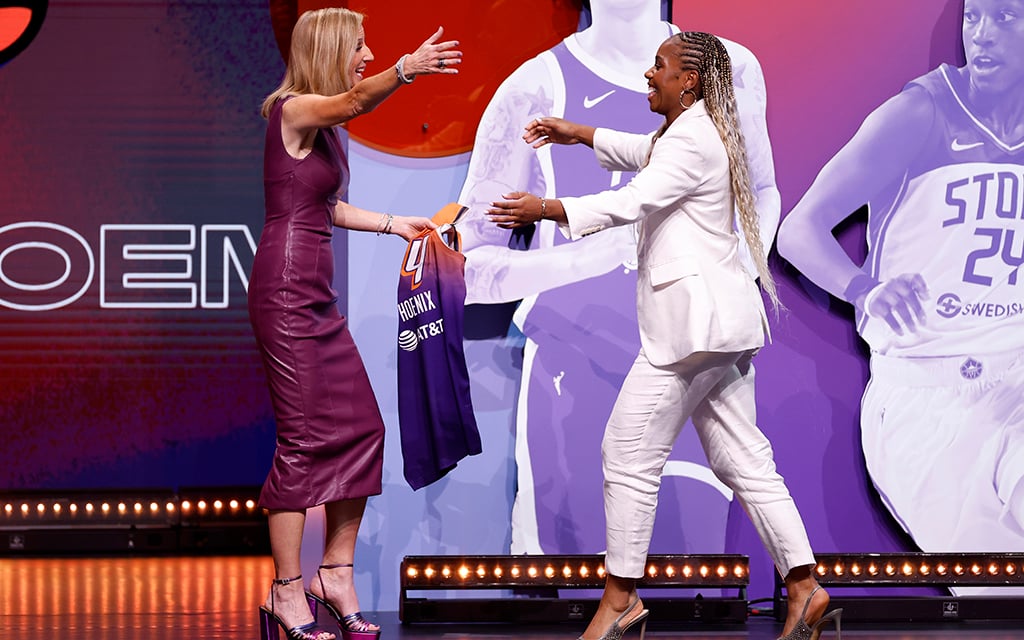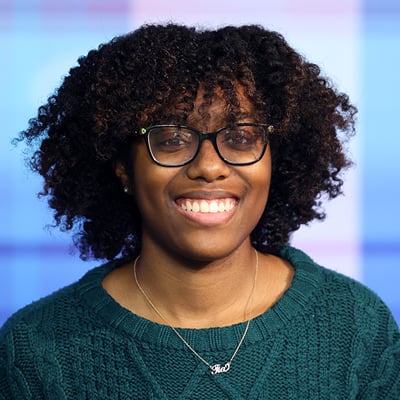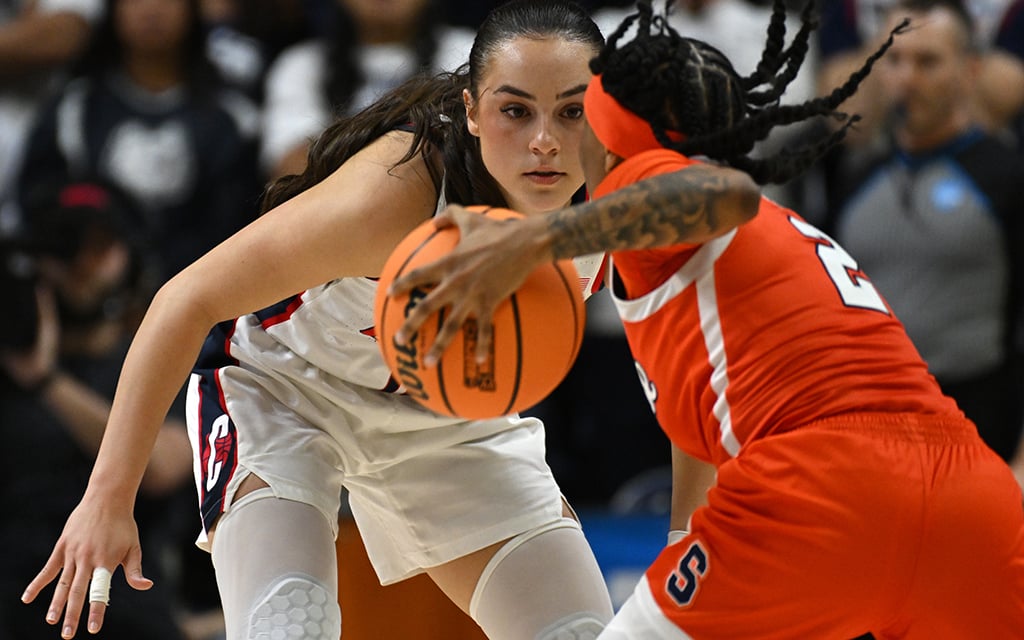
Charisma Osborne’s dream of playing in the WNBA took a step forward by getting drafted, but now the real test begins as she vies for one of Phoenix’s final roster spots. (Photo by Sarah Stier/Getty Images)
PHOENIX – With just 144 available roster spots, the WNBA is widely recognized as the hardest professional league to make a roster in. Every year, college stars and fan-favorite veterans are cut during training camp as each of the league’s 12 teams whittle their rosters down to 12 players. Due to cap space, some don’t even carry that many.
As this year’s draftees and rookie free agents compete in their first training camp, the possibility of being cut at a moment’s notice stays in their minds, keeping them on their toes for anything their new coaches and teammates may throw at them.
“I can’t overstate it,” ESPN women’s basketball analyst Rebecca Lobo said. “This is the hardest league to make a roster spot, and draft night is really exciting, and so we don’t want to necessarily talk about how hard it is on draft night because the second- and third-rounders have just had their dreams come true, but it’s hard. It’s hard, and we’ve even seen in recent years first-round picks who weren’t able to stick their rookie year, so it’s tough.”
For the Phoenix Mercury though, this year may be a different story. Both of their new rookie draftees came in the third round, with UCLA’s Charisma Osborne selected 25th overall and Nebraska’s Jaz Shelley taken 29th. The team also signed Washington State’s Bella Murakatete as an undrafted rookie free agent.
The Mercury entered this year’s draft with the mindset that they might be able to keep a rookie or two on the roster, according to team scout Charli Turner Thorne. It certainly became more of a possibility when Osborne, a projected first-round pick, fell to the Mercury in the third round.
“We thought to get a kid that was projected first round or high second round with our third-round pick was amazing,” Turner Thorne said. “And we’re actually one of the teams that we have a spot or two. We could keep people.
“So even though it’s like, ‘Oh, we have two third-round picks, we were extremely focused to possibly get somebody that might actually even make our team because we’re not in that situation that a lot of the teams are in this year, which is (they) have 11, 12 returners, and (they) really aren’t going to keep anybody.”
To predict a player’s potential success in the league, scouting carries more weight than just their on-court performance. Observations revolve around their character and work ethic, two things that are crucial for college athletes looking to take the next step.
It’s especially important for players to get in the right mindset with the quick turnaround between the NCAA and WNBA seasons. The NCAA national championship game was on April 7. The WNBA Draft happened on April 15, and WNBA training camp kicked off Sunday. The regular season will start on May 14, just about a month after the draft.
“The quick turnaround is definitely huge,” Turner Thorne said. “Just I think learning everything new, you know, new coach, new terminology, if you don’t learn well, it’s going to be really tough to make a team. The physicality and the speed of the game is definitely there’s a difference.
“The other thing is they just have to adjust to being a pro. No one’s holding their hand. No one’s checking on them, telling them when to go to bed, what to do. I mean, they really have to be mature about, ‘I’m a pro,’ and know how to handle their business and manage their life and be really responsible because, in college, we tend to really support them and take care of them. Obviously, they’re kind of in their little bubble, their protective support bubble, and that is gone in the pros.”
Before pro-caliber players prepare to leave college for the next level, there are several things their collegiate coaches do to prepare them for what’s coming. ASU women’s basketball coach Natasha Adair has coached her fair share of players to the WNBA, including five-time WNBA champion and current Minnesota Lynx assistant coach Rebekkah Brunson, Los Angeles Sparks forward Dearica Hamby and most recently Jasmine Dickey, the 30th overall draft of the 2022 draft.

ASU women’s basketball coach Natasha Adair knows the extra guidance and work she provides for her players could help them reach their dreams of playing in the WNBA. (Photo by Sam Wasson/Getty Images)
In preparing each of these three players, there were specific differences based on their positions and the era of basketball. There were also recognizable similarities in the eyes of Adair, such as their passion, work ethic and on-court demeanor, that foreshadowed their future WNBA aspirations becoming a reality in some manner.
“They were phenomenal teammates,” Adair said. “Sometimes you see talented players, or what people deem as the nation’s best players, maybe it’s hard to play with them, but it was not hard to play with those three. They made their teammates better. They got excited for their teammates more than themselves, so they were selfless in their approach, but I just think, in their own time, different generations, obviously, the common denominators are the same.”
While coaching those players to help their college programs succeed while also preparing for a pro career, it was about finding a balance. Many players enter college with their eyes set on playing professional basketball, opening an avenue for coaches to guide them and train them to reach that goal.
Adair says creating that routine can include extra workouts to help the players advance their skills. She says it’s also about bringing in players who fit the system. Many of the skills that made players elite prospects to WNBA scouts and executives also made them hard to stop and contain for opposing NCAA teams.
“Rebekkah Brunson was probably one of the most phenomenal rebounders of her time,” Adair said. “Well, that fits into who I am and how we want to play, so she just excelled at it for our team. Dearica Hamby was a perimeter post, so she could stretch defenses, but our trail fours shoot the three. So with their skill set, even it being exceptional, it just made us have more success because they were very talented at it, so it didn’t take away from what the team needed to do.”
Even with all the effort coaches put into preparing their players and giving them all the necessary tools they need to move on to the next stage of their basketball careers, it still doesn’t work out for everyone.
After being drafted, Dickey made the Wings’ roster and played 20 games in her rookie season. In her second year, Dickey was waived after 14 games played on June 28, just a month and a half into the 2023 season. She has yet to sign a new WNBA contract since then.
Like many other players who struggle to find a permanent home on American soil, Dickey turned to an overseas league to continue her development with hopes of making it back to the WNBA. This offseason, Dickey played for the WNBL’s Southside Flyers in Australia, where she averaged 8.4 points and 3.4 rebounds while playing a role in the Flyers’ WNBL title run.
“It’s hard to make the WNBA and sustain it, and so was she disappointed when the Wings let her go? Absolutely,” Adair said. “But to speak to who she is as a competitor, she went overseas … and so I think with her experience in the WNBL, you don’t know if she’s going to get picked up. She may get picked back up to a (WNBA) team. …
“And so I think that she’s going to stay focused and she’s going to continue to feed her passion and her drive, and whatever it is she’s going to do, whether it be in the (WNBA), whether it be overseas, she’s going to still put herself in a position to be the best one of the best, and a champion.”
Right now the WNBA only stands at 144 spots. With the new Bay Area franchise slated to begin play in 2025, that number will soon expand to 156. At the WNBA draft, Commissioner Cathy Engelbert set a goal of 16 teams by 2028, which would total 192 opportunities. Until then, rookies will keep fighting to break into the top 144 and college coaches will keep doing everything they can to support their players taking that leap.
“It starts as soon as they get there really,” Adair said. “You talk to them in the recruiting process. You talk about the goals that they have and the players will tell you right away, ‘I want to play at the next level. I want to play in the WNBA,’ or ‘I want to play overseas.’ So as a coach, you know that right up front and normally in any preparation that we have, as a coach, you’re going to prepare your players regardless, but the players that want to play at that next level, it’s just a little bit more.”

